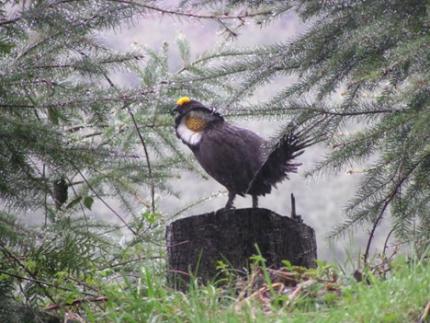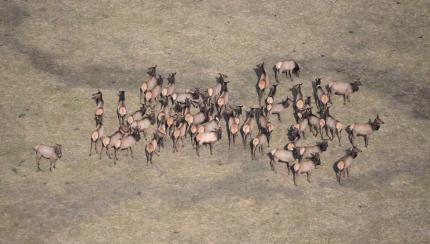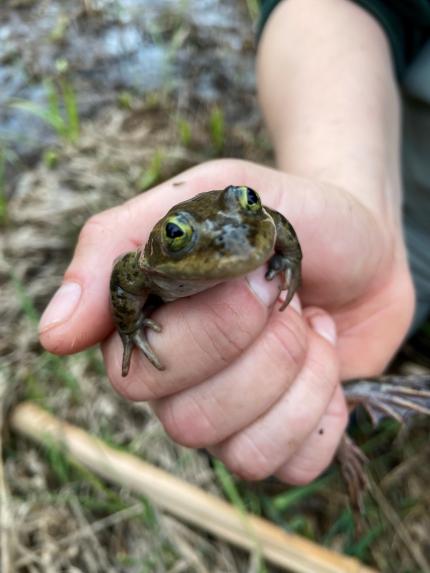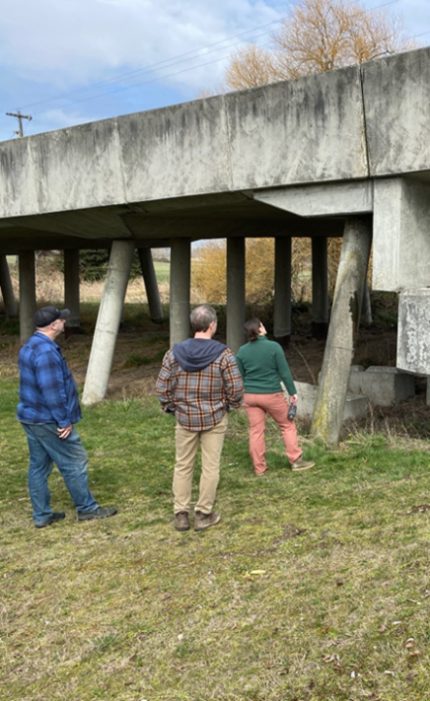Managing Wildlife Populations
Forest Grouse Wingbee: District Wildlife Biologists Anderson, Smith, Licence, and Waddell participated in a forest grouse wingbee with other WDFW staff. Staff members examined grouse wings and tails submitted by hunters during the past grouse hunting season to determine species type, age, and sex for each specimen submitted. This helps WDFW understand the proportion of each species of forest grouse in the harvest, as well as proportions of males, females, adults, and juveniles. Hunters can submit wings and tails for each bird harvested at collection points located in each district.


Sooty Grouse Hoot Surveys: Biologists Anderson, Smith and many other west side of crest district biologists began laying out sooty grouse survey routes to be prepared for future annual surveys. 2023 is a pilot year. Efforts are coordinated with Oregon Department of Fish and Wildlife as we are using the same protocol with, perhaps, some adjustments in timing due to farther north latitude.
Annual Snow Goose Survey: WDFW District Wildlife Biologist Waddell and Canadian Wildlife Biologist O’Shea conducted an aerial snow goose survey in southern British Columbia and Whatcom, Skagit, and Snohomish counties. Northwest Washington and southern British Columbia represent an important wintering area for many tens of thousands of snow geese. Staff members took multiple photos of each flock that will be stitched together using photo-editing software. The finished composite image for each flock will be analyzed using sophisticated software that counts the birds in each photo.



North Cascades Elk Herd Survey: District Wildlife Biologists Waddell, Moore, and Licence worked with co-managers from the Point Elliott Treaty Tribes to survey the North Cascades elk herd. Helicopter surveys are conducted in 13 survey units to generate a population estimate and cow elk estimate for the survey area. Analysis of the data is in progress.


Oregon Spotted Frog Surveys: District Wildlife Biologists Moore and several volunteers conducted egg mass surveys for Oregon spotted frogs (OSF) at new sites and locations where frogs have been documented in the past. Biologists also collected individual eggs for a study that will use genomics techniques to estimate genetic diversity, population structure, demographic history, identify adaptive alleles, and inform the need for evolutionary rescue of OSF based on genetic patterns of inbreeding.



White-nose Syndrome (WNS) Research in Snohomish County: District Wildlife Biologist Licence and Species Lead/WNS Coordinator Tobin met with Snohomish County Public Works and a private landowner to discuss and assess a Yuma myotis and little brown bat maternity roost for a WNS research project. The project will assess the effectiveness of a treatment to enhance survival of WNS susceptible bat species and includes many partners including United States Geological Survey, Wildlife Conservation Society Canada, and Woodland Park Zoo. Final approval of the site is still pending, but promising. Similarly, a system to monitor individual bat movements for the same study was installed on an existing research site near Darrington.

Sound Transit Light Link – West Seattle to Ballard – Great Blue Heron Colony: Biologist Anderson consulted with Sound Transit environmental staff working on the West Seattle to Ballard light link extension. A heron colony is within the project footprint and take activities are very likely throughout the project. Sound Transit has been in consultation with WDFW Habitat Program, Priority Habitats and Species (PHS) meeting local Seattle critical areas code, and Wildlife Program, to state take of protected wildlife needs. The project is moving along with wildlife consideration efforts where appropriate to meet local code or state law. WDFW appreciates the proactive efforts of Sound Transit.
Species of Greatest Conservation Need – Habitat Program WSDOT Culvert Replacement Efforts – Harlequin Duck Considerations: Biologist Anderson worked with the Waterfowl Section Manager Spragens and Specialist Hamer to provide recommendations to Habitat Program for culvert replacement efforts where known nesting/breeding harlequin ducks have been documented. Harlequin ducks are listed as a Species of Greatest Conservation Need (SCGN) in the State Wildlife Action Plan (SWAP) and the Habitat Program categorizes this species as a Priority Habitat Species via their PHS management recommendation program. A project in King County is the first in the new Habitat Program project screening efforts. There is a desire to ensure all Wildlife Program consultation provides uniformity across the current King County effort, as well as future requests in regard to harlequin ducks in Washington.
Wolf Monitoring in Snohomish County: Biologist Licence and Statewide Wolf Specialist Ben Maletzke investigated a large canid report on Olo Mountain which is private industrial timberland near Granite Falls. Upon investigation, only coyote sized tracks were observed, and no other signs of wolves were discovered. Two additional trail cameras were deployed in the county and one was checked, although no wolves were detected.
Providing Conflict Prevention and Education
On Mar. 20, Wildlife Conflict Specialist O’Connor worked with a group of volunteer master hunters to assist a dairy farm in the Enumclaw area. Conflict staff and master hunters repaired barbed wire, cleared blackberry and grass, and helped the farmer design electric fencing to exclude elk from the cow pasture. Wildlife exclusion fencing and electric fencing is an excellent way to keep wildlife out of pastures, gardens, and large commercial agricultural areas. Master hunter volunteers are eager to assist landowners in fencing projects and conflict staff is always happy to help farmers design wildlife exclusion fencing and electric fencing projects!
Providing Education and Outreach
Wildlife Conflict Specialist O’Connor gave a bear awareness presentation to the board members of the Trilogy Community in the Redmond area. The presentation focused on co-existing with Washington’s resident blear bear population as they are frequently observed in semi-urban areas adjacent to greenbelts and natural spaces. The Trilogy and Redmond communities, like many residentials areas of western Washington, often see these charismatic animals passing through their greenbelt-adjacent backyards, golf courses, and open spaces which makes education and outreach a primary focus for WDFW conflict specialists moving into the spring season. Reducing human sourced attractants is the number one thing we can do as a community to reduce potential conflict with wildlife. By removing bird feeders, garbage containers, and pet food, we encourage natural black bear foraging behavior and make our communities safer for both people and black bears.
Wildlife Conflict Specialist O’Connor assisted Bear and Cougar Specialist Welfelt with a black bear presentation given to King County Parks employees focusing on safely working and recreating in bear country. Washington is bear country and it not uncommon to see these animals in our state’s diverse park system. By reducing human sourced attractants, locking garbage in bear resistant containers, clearing brush from buildings and picnic areas, and maintaining awareness of our surroundings, we can significantly increase safety while working and recreating in our natural spaces.
Other
Wildlife Conflict Specialist O’Connor attended the Human-Carnivore Interaction Response Training in Moses Lake, Washington. This training was provided to WDFW conflict staff to increase our knowledge of carnivore ecology, populations, and distribution as well as respond to carnivore-livestock interaction.